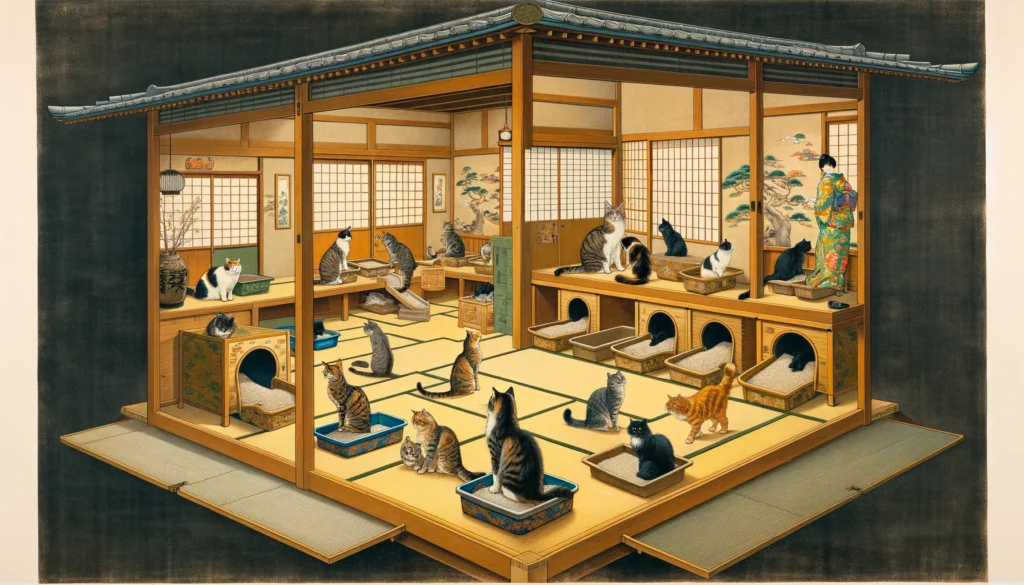Last updated on March 23rd, 2024
Is managing litter boxes in a multi-cat households a puzzle? Don’t fret! Our guide on Multi-Cat Households: Litter Box Training Strategies dives into simple yet effective methods to create harmony and cleanliness.
Whether you’re a seasoned cat parent or new to the game, mastering the art of cat litter management is essential for a happy, odor-free home.
Ready to tackle the challenge? Here are some quick tips:
- Establish a litter box for each cat, plus one extra.
- Regularly clean each box to prevent unpleasant odors.
- Position boxes in quiet, secluded spots to give each cat privacy.
With these strategies, you’ll set the stage for a peaceful multi-cat living situation. Let’s jump into the world of litter box bliss!
Key Takeaways from “Multi-Cat Households: Litter Box Training Strategies”
- Understand Each Cat’s Needs: Recognize and cater to the individual needs of each cat in your household for a peaceful coexistence.
- Maintain a Clean Environment: Regular cleanliness and proper placement of litter boxes are crucial to avoid aversions and maintain hygiene.
- Observe and Adapt: Stay attentive to the changing dynamics in your multi-cat household and adjust your strategies accordingly.
- Utilize Proper Litter Box Training: Implement effective training strategies, ensuring each cat has its own litter box plus one extra.
- Stress-Free Home: Create a serene environment to reduce stress-related issues among your cats.

You May Also Like: 5 Amazing Tips on how to train an outdoor cat to use a litter box
So, why is this important? Mastering these strategies ensures a harmonious and healthy living situation for you and your feline family members.
By understanding and addressing the unique challenges of multi-cat households, you can prevent common litter box problems and foster a loving, stress-free environment for all your cats.
Understanding the Dynamics of Multi-Cat Homes
Each cat is an individual with unique needs and personalities.
- Cats are territorial: They need their own space, including separate litter boxes.
- Different cats, different habits: Some may prefer covered boxes, while others like open spaces.
- Peacekeeping: Preventing conflicts over litter boxes can reduce stress for everyone.
Identifying Common Issues in Multiple Cats’ Households
In a multi-cat household, the litter box can become a battleground. Let’s pinpoint common problems to keep the peace:
- Overcrowding: Too few litter boxes can lead to tension and accidents.
- Territorial disputes: Cats may block access to boxes as a power move.
- Preference clashes: Not all cats like the same type of litter or box.
The Importance of Individual Spaces
Just like humans, cats value their personal space. In a home bustling with feline activity, individual spaces become sanctuaries.
- Personal litter boxes: Each cat should have its own, plus one extra.
- Private areas: Separate feeding and resting areas reduce competition.
- Escape routes: Ensure cats can leave the litter box area without confrontation.

Further Reading
FAQs on Litter Box Training in Multi-Cat Households
Q: What’s the litter box rule for many cats?
A: The rule is to have one litter box per cat, plus one extra, to prevent competition and stress among cats.
Q: How can you make all your cats use the litter box?
A: Introduce each cat to the litter box individually and maintain cleanliness to encourage its use.
Q: What’s the best way to handle litter in a house with lots of cats?
A: Regular cleaning and having multiple litter boxes help manage litter effectively in multi-cat homes.
Q: Where should you place litter boxes in a house with many cats?
A: Place litter boxes in quiet, accessible locations throughout the home, avoiding high-traffic areas.
Q: Is it cool for three cats to share one litter box?
A: No, it’s recommended each cat has its own litter box to avoid conflicts and hygiene issues.
Q: Do cats living together need one litter box each?
A: Yes, each cat should have its own litter box to ensure they feel safe and comfortable.
Q: Can you place two litter boxes right next to each other?
A: It’s better to spread them out to give your cats more options and privacy.
Q: What mistakes do people make that make cats not use the litter box?
A: Not cleaning the litter box regularly and placing it in noisy areas can discourage cats from using it.
Q: Is an open or closed litter box better?
A: It depends on your cat’s preference; some like the privacy of a closed box, while others prefer the openness of an uncovered one.
Q: Is having two litter boxes okay for three cats?
A: It’s better to have at least one box per cat, so for three cats, three boxes are ideal to prevent issues.
Q: How many litter boxes are needed for three cats?
A: You should have at least four litter boxes for three cats to ensure there are enough options for all.







